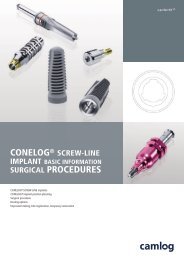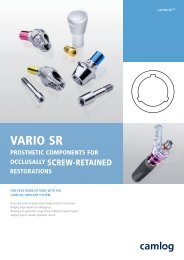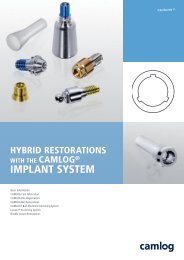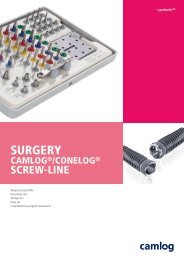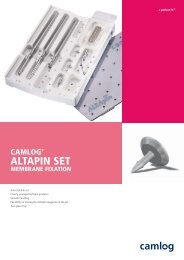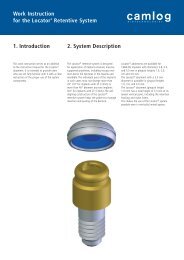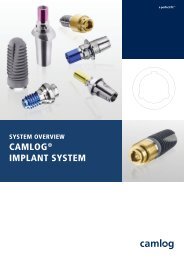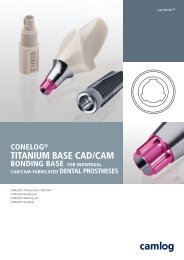CONELOG® Implant System Prosthetic Restorations - Camlog
CONELOG® Implant System Prosthetic Restorations - Camlog
CONELOG® Implant System Prosthetic Restorations - Camlog
You also want an ePaper? Increase the reach of your titles
YUMPU automatically turns print PDFs into web optimized ePapers that Google loves.
DOUBLE CROWN RESTORATION WITH THE<br />
CONELOG ® GOLD-PLASTIC ABUTMENT<br />
INTRODUCTION<br />
CONELOG ® gold-plastic abutments can be used to fabricate a double crown<br />
restoration. The rotational stability of the CONELOG ® implant abutment<br />
connection and high precision manufacturing make the CONELOG ® abutments<br />
(including universal and telescope abutments) well-suited for fabrication<br />
of double crown restorations.<br />
Two different methods are used for fabricating the secondary copings:<br />
• Electroformed secondary copings.<br />
• Cast secondary copings similar to the double crown technique.<br />
For removable superstructures of this type, we recommend inserting at<br />
least 6 implants in the maxilla and at least 4 implants in the mandible. The<br />
prosthesis design should prevent overloads by extensions. The tension-free<br />
seat of a secondary (double crown) or primary (bar) splinted structure on<br />
implants is called as «passive fit». With double crown constructions, this is<br />
obtained through intraoral bonding of the secondary copings (e.g. electroformed<br />
copings) to a tertiary framework. The tension-free seat of the superstructure<br />
is of paramount importance for the long-term prognosis of a prosthetic<br />
restoration. We recommend bonding secondary copings intraorally<br />
in the tertiary framework.<br />
IMPRESSION TAKING AND FABRICATION<br />
OF THE PLASTER MODEL<br />
For double crown restorations, the impression is taken with CONELOG ®<br />
impression post, open or closed tray (see pages 18–24).<br />
For cast fabrication, CONELOG ® lab analogs are used (see pages 25–28).<br />
CONELOG ® IMPLANT SYSTEM<br />
PROSTHETIC RESTORATIONS<br />
CAST FABRICATION FOR MILLING TECHNIQUE<br />
For milling the CONELOG ® abutments, we generally recommend creating a<br />
separate milling cast. The milling cast is fabricated by transferring the<br />
CONELOG ® lab analog positions from the working cast using CONELOG ®<br />
impression posts, which are connected in a transfer construction with suitable<br />
acrylic. The construction is connected with acrylic in the retentive area<br />
of the impression posts. Acrylic must not get on the fixing screws.<br />
Working cast with CONELOG ® Lab<br />
analogs<br />
Placing the CONELOG ® Impression<br />
post, open tray<br />
61




